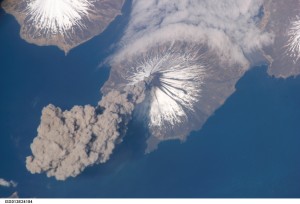by Luisa Cristini, PhD, University of Hawaii at Manoa.
[Note from the editor: This is the ninth in a series of blog entries that will focus on introductory topics in climate dynamics and modeling, and will be a great insight into the current understanding of the science.]
The climate system can be influenced by different perturbations: changes in the amount of incoming solar radiation, in the composition of the atmosphere, in the topography of the surface, etc. In order to compare the magnitude of those perturbations and to evaluate their effect on the climate, it is convenient to analyze their impact on the radiation balance of the Earth. More precisely, radiative forcing is commonly defined as the net change in the Earth’s radiative budget caused by the perturbation.
Major radiative forcings include: greenhouse gases, aerosols, land use changes, and solar and volcanic forcings.
Over the last 250 years, the changes in greenhouse gas concentrations have played a dominant role. The largest contribution comes from the modification of the atmospheric carbon dioxide (CO2) concentration, with a radiative forcing of about 1.7 W/m2 between 1750 and 2005. However concentrations of methane (CH4), nitrous oxide (N2O) and the halocarbons (organic compounds in which one or more carbon atoms are linked with one or more halogen atoms – fluorine, chlorine, bromine or iodine) also need to be taken into account. Carbon dioxide, methane, nitrous oxide and halocarbons are long-lived gases that remain in the atmosphere for decades to centuries. Their geographical distribution is thus quite homogenous. Other greenhouse gases such as ozone (O3) have a shorter life and their concentrations, and the associated radiative forcing, tend to be higher close to areas where they are produced, and lower near areas where they are destroyed.
Atmospheric aerosols are relatively small solid or liquid particles that are suspended in the atmosphere. They are largely natural: they may be generated by evaporation of sea spray, wind blowing over dusty regions, forest and grassland fires, living vegetation, volcanoes, etc. Human activities also produce aerosols by burning fossil fuels or biomass, and by the modification of natural surface cover that influences the amount of dust carried by the wind. Since the majority of aerosols only remain in the atmosphere for a few days, anthropogenic aerosols are mainly concentrated downwind of industrial areas, close to regions where land-use changes have led to dustier surfaces (desertification) and where slash-and-burn agricultural practices are common. As a consequence, maximum concentrations are found in eastern North America, Europe, and eastern Asia as well as in some regions of tropical Africa and South America. Aerosols directly affect our environment, as they can contribute to health problems and acid rain, for instance. They also have multiple direct, indirect and semi-direct effects on the radiative properties of the atmosphere.
Humans have been modifying their environment for millennia, in particular through deforestation. Before 1950, this mainly occurred in Europe, North America, India and China, leading to large areas of cropland in these areas. In the last 50 years, the extension of cropland has been stabilized in many places, some regions even showing an increase in the surface covered by forest. By contrast, deforestation has occurred rapidly over this period in many countries in the tropics. Deforestation has a direct impact on emissions of carbon dioxide and methane as well as on the production of dust aerosols and of aerosols due to biomass burning. Furthermore, the anthropogenic changes in land use have altered the characteristics of the Earth’s surface, leading to changes in the energy and moisture budgets.
Natural forcings such as those associated with explosive volcanoes and changes in the radiant energy emitted by the Sun and expressed by the total solar irradiance (TSI), also affect the Earth’s climate. Various methods have been used to extend our estimates of the changes in TSI back in time. The number of Sun spots, observed since around 1610, and the production of the cosmogenic isotopes 14C (carbon 14) and 10Be (beryllium 10), created when elements in the atmosphere or on Earth are bombarded by cosmic rays, are both known to be related to solar activity. However, additional work is still required before making a clear quantitative link between these indirect measurements and variations in TSI.
Major volcanic eruptions have a dramatic local impact causing fatalities and damage to properties, crops, forest etc. The ash produced can travel hundreds of kilometers, altering atmospheric properties for days or weeks and modifying the characteristics of the Earth’s surface after its deposition. Explosive volcanic eruptions can even have an influence on a larger spatial scale, affecting the whole of the Earth’s climate significantly. Indeed, they can transport aerosols directly to the stratosphere where they remain for a few years and affect nearly all regions.
Reference
Goosse H., P.Y. Barriat, W. Lefebvre, M.F. Loutre and V. Zunz, (2012). Introduction to climate dynamics and climate modeling. Online textbook available at http://www.climate.be/textbook.


Comments are closed.